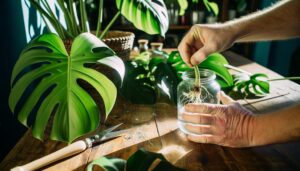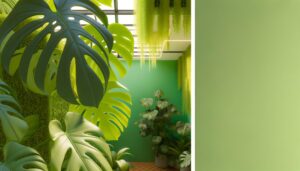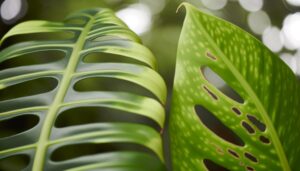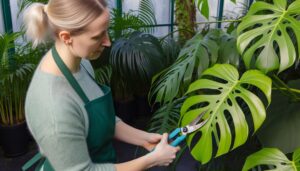Monstera Adansonii Aurea Vs Albo
When comparing Monstera Adansonii Aurea and Albo, focus on their variegation, growth, and care. The Aurea boasts yellow blotches, producing leaves more vigorously with shorter internodes.
Albo features white patches and grows slower due to higher energy demands. Both require bright, indirect light and systematic watering when the top inch of soil is dry.
Use well-draining soil with organic matter and balanced fertilizer for optimum health. Aurea climbs more aggressively compared to the spread-out appearance of Albo.
Proper light, soil, and watering will keep your Monstera thriving. For a deeper understanding of care nuances and troubleshooting, continue exploring.
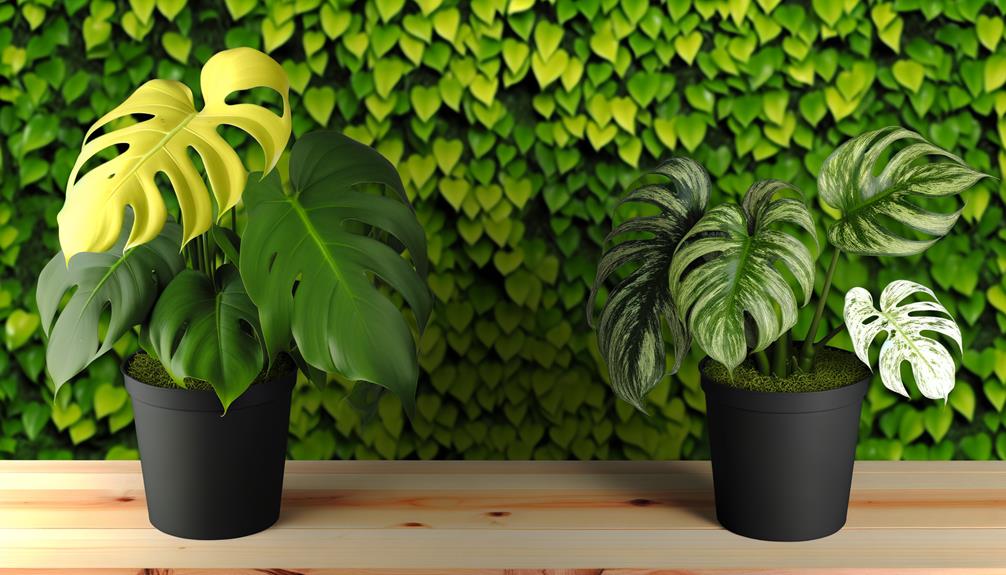
Key Takeaways
- Monstera Adansonii Aurea features yellow variegation, while Albo has white variegation.
- Aurea grows faster and has denser foliage compared to the slower-growing Albo.
- Aurea's internodal spacing is shorter, giving it a bushier appearance than Albo.
- Both thrive in bright, indirect sunlight but avoid direct exposure to prevent leaf burn.
- Well-draining soil and consistent watering, allowing the top inch to dry, are essential for both varieties.
Appearance and Variegation
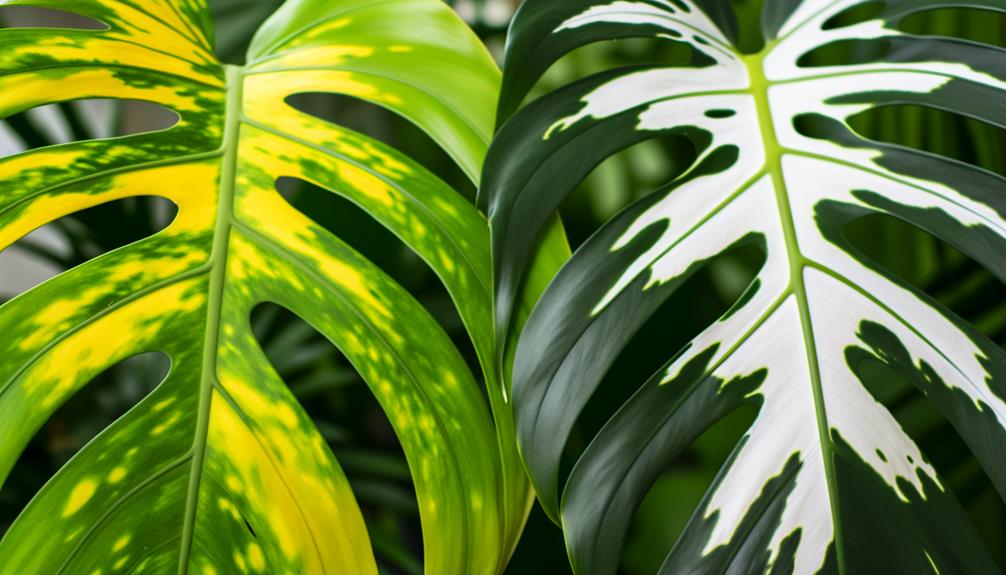
When comparing the appearance and variegation of Monstera Adansonii Aurea and Albo, you'll notice distinct differences in leaf coloration and pattern.
The Aurea variety exhibits a striking yellow variegation, where chlorophyll-deficient sections create a vibrant contrast against the green. These yellow patches are typically irregular, often forming blotches or streaks distributed across the leaf surface.
In contrast, the Albo variant displays white variegation, resulting from the absence of pigmentation in specific areas. The white sections can appear as larger patches or delicate marbling, offering a more subtle, yet equally alluring, aesthetic.
Both types maintain the characteristic fenestrations of Monstera Adansonii, but it's the coloration that sets them apart, making each uniquely appealing to plant enthusiasts.
Growth Patterns
Monstera Adansonii Aurea and Albo exhibit distinct growth patterns. Aurea tends to grow more vigorously under ideal conditions, developing faster and producing new leaves at a quicker rate. The internodal spacing on Aurea can be shorter, resulting in a denser appearance.
Albo, on the other hand, grows more slowly due to the energy demands of maintaining its variegation. Its leaves often unfurl at a slower pace, and the plant might exhibit longer internodal spacing, giving it a more spread-out look.
Both varieties climb when provided with support, but Aurea's more robust growth makes it a more aggressive climber. Understanding these patterns helps you manage their care more effectively.
Light Requirements

Proper light exposure is crucial for the health and vibrancy of both Monstera Adansonii Aurea and Albo. You'll want to place these plants in a location where they can receive bright, indirect sunlight. Direct sunlight can cause leaf burn, resulting in unsightly brown spots.
For best growth, aim for a light intensity of around 10,000 to 20,000 lux. If natural light is insufficient, consider using full-spectrum grow lights. Position them approximately 12 inches above the foliage to mimic natural conditions.
Monitor the leaf color and growth rate; pale or slow-growing leaves indicate inadequate light, while yellowing suggests excessive light. Consistent light levels will guarantee robust variegation and healthy development for both Monstera Adansonii Aurea and Albo.
Watering Needs
Maintaining the proper watering schedule is essential for preserving the health and vibrancy of both Monstera Adansonii Aurea and Albo. You should water these plants when the top inch of soil feels dry to the touch.
Overwatering can lead to root rot, so guarantee sufficient drainage by using pots with multiple drainage holes. It's vital to monitor the ambient humidity; both varieties thrive in environments with 60% humidity or higher. Utilize a humidity meter for accurate measurements.
Watering frequency may vary based on seasonal changes; reduce watering in winter when growth typically slows. Employing a systematic approach to watering will maintain the best hydration levels, ensuring your Monstera Adansonii Aurea and Albo remain flourishing and vibrant.
Soil and Fertilization
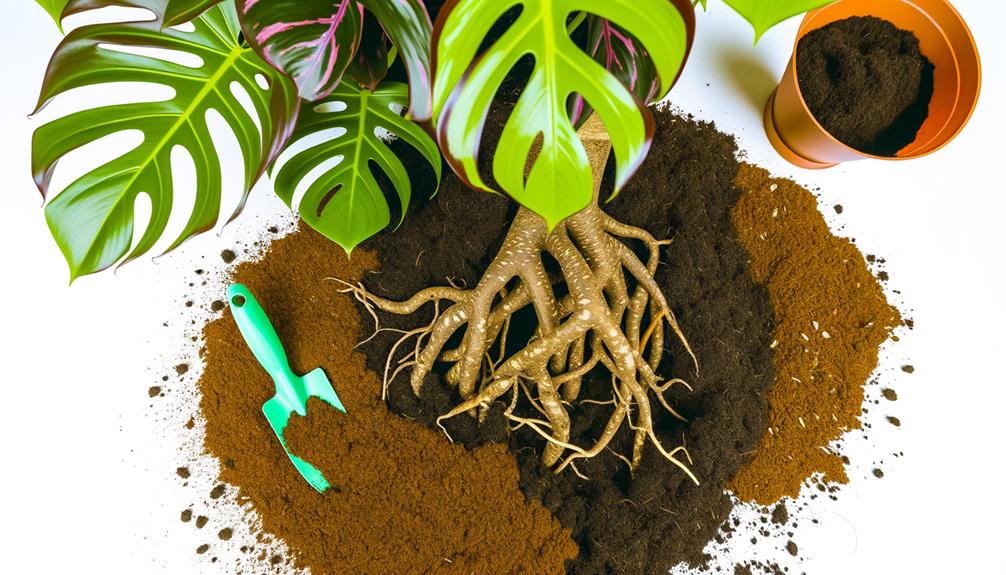
You need well-draining soil with high organic matter for both Monstera Adansonii Aurea and Albo.
Use a balanced, water-soluble fertilizer monthly during the growing season to promote healthy foliage.
Maintain the soil retains moisture without becoming waterlogged to prevent root rot.
Ideal Soil Composition
To cultivate thriving Monstera Adansonii Aurea and Albo plants, using well-draining soil rich in organic matter is essential. Maintaining proper aeration and moisture retention without waterlogging is key. Here's a systematic approach to an ideal soil composition:
- Peat Moss (30%): Enhances moisture retention and provides organic content, supporting root health.
- Perlite (20%): Improves drainage and aeration, preventing root rot by allowing excess water to escape.
- Pine Bark (50%): Adds structure and stability, promoting air circulation around the roots and maintaining a balanced pH.
Combine these components thoroughly to create an ideal environment for your Monstera Adansonii Aurea and Albo plants. This mixture guarantees they receive the necessary nutrients, aeration, and hydration for strong growth.
Optimal Fertilizer Choices
Achieving ideal growth for Monstera Adansonii Aurea and Albo plants also involves selecting the right fertilizers to complement their nutrient-rich soil. You'll need a balanced, water-soluble fertilizer with an N-P-K ratio of 20-20-20. Apply this bi-weekly during the growing season. Organic options like worm castings or fish emulsion can also be beneficial, applied monthly.
```markdown
| Fertilizer Type | Frequency | Benefits |
|---|---|---|
| 20-20-20 N-P-K | Bi-weekly | Well-rounded nutrient supply |
| Worm Castings | Monthly | Improves soil structure |
| Fish Emulsion | Monthly | Enhances microbial activity |
```
Ensure you dilute synthetic options to half-strength to prevent root burn. Regularly monitor soil pH to maintain an ideal range of 5.5-7.0, optimal for nutrient absorption.
Common Issues and Solutions
Dealing with common issues like leaf browning and pest infestations in Monstera Adansonii Aurea and Albo requires understanding their specific care needs and environmental preferences. Addressing these challenges involves a systematic approach:
- Leaf Browning: Maintain consistent moisture levels by watering when the top inch of soil is dry. Avoid direct sunlight, which can cause scorching.
- Pest Infestations: Regularly check leaves for signs of aphids or spider mites. Use insecticidal soap or neem oil for treatment.
- Yellowing Leaves: Monitor for overwatering. Guarantee proper drainage to prevent root rot, and adjust watering frequency based on humidity and temperature.
Conclusion
To sum up, both Monstera adansonii aurea and albo offer unique aesthetics with their distinct variegation patterns. While some might argue that their growth and care requirements are too specific, grasping their needs guarantees healthy plants.
With meticulous attention to light, water, soil, and potential issues, you can successfully cultivate either variety. Embrace their differences and apply systematic care practices to enjoy the beauty these stunning plants bring to your indoor garden.


